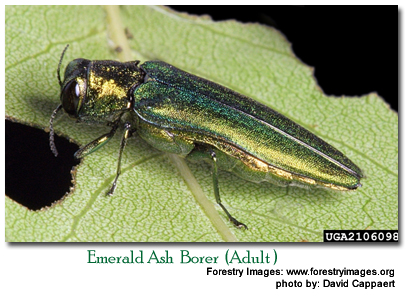 The emerald ash borer has found its way to Titletown. An adult beetle was discovered last Thursday stuck to a survey trap in an ash tree on public land next to the Fox River, roughly a mile south of the bay.
The emerald ash borer has found its way to Titletown. An adult beetle was discovered last Thursday stuck to a survey trap in an ash tree on public land next to the Fox River, roughly a mile south of the bay.
A survey specialist with the Wisconsin Department of Agriculture, Trade and Consumer Protection (DATCP) discovered the beetle during a routine trap check in the area. The specimen was confirmed by federal identifiers at a lab in Michigan on Friday. Brown County marks the fifth Wisconsin county to have confirmed the presence of EAB since the state’s first detection last summer in Newburg, on the Ozaukee-Washington county line. The tree-killing beetle has also been confirmed in Vernon and Crawford counties.
“Part of the state’s initial response will be working together with local officials and experts to determine the extent of the infestation and to develop a response to this infestation,” said Jennifer Statz, EAB program manager with DATCP. “This won’t be a quick process given the sizeable ash population in the area.”
Presenting another difficulty is the fact that EAB was confirmed in the area based on the capture of an adult beetle, not by the presence of the insect larva in a tree.
“We have to try to determine if there are infested trees nearby, or from some far away source,” Statz said. “This beetle may have emerged from a tree across the street, across the river, or across the county. At this point, we just don’t know.”
Federal regulators are considering a quarantine of Brown County and possibly other counties in the area in an effort to help slow the spread of EAB throughout northeastern Wisconsin. Materials to be quarantined include ash nursery stock, ash timber, tree trimmings and all hardwood firewood.
“Anything that could transport a life stage of the beetle is going to be under quarantine,” said Bob Dahl, DATCP’s chief regulator. “Some businesses will be able to qualify for compliance agreements that will allow them to continue operating.
“Even before the quarantine goes into effect, it’s important for people in the Green Bay and Brown County area to stop moving ash products, especially hardwood firewood,” Dahl added. “Firewood is our main concern when it comes to EAB.”
The emerald ash borer was discovered near Detroit in 2002, likely arriving in North America accidently transported in wooden shipping crates from China. They’ve destroyed millions of trees already and have been found in 11 other states and in two Canadian provinces, Ontario and Quebec.
It’s the beetle’s larva that actually kills the host ash tree by tunneling through the soft wood that supplies the tree with food and water. Large, healthy trees can succumb to EAB usually within three to five years. But the signs of an infestation in a tree can be very subtle at first, and it’s usually too late to save the tree once its determined that EAB is the cause of the problem.
Area residents concerned about the health of their ash trees should consult with professionals. There are a variety of treatments available for homeowners, though none are guaranteed to prevent or reverse an infestation.
A partnership of state and federal agencies including DATCP, USDA APHIS Plant Protection and Quarantine and the Wisconsin Department of Natural Resources continues to survey infested areas in Wisconsin and other parts of the state for the destructive forest pest. The University of Wisconsin- Madison, the UW Extension and the USDA Forest Service are also partners in evaluating management options and in outreach to residents and local units of government.
For additional information about emerald ash borer, please visit the Wisconsin EAB Website at www.emeraldashborer.wi.gov.




